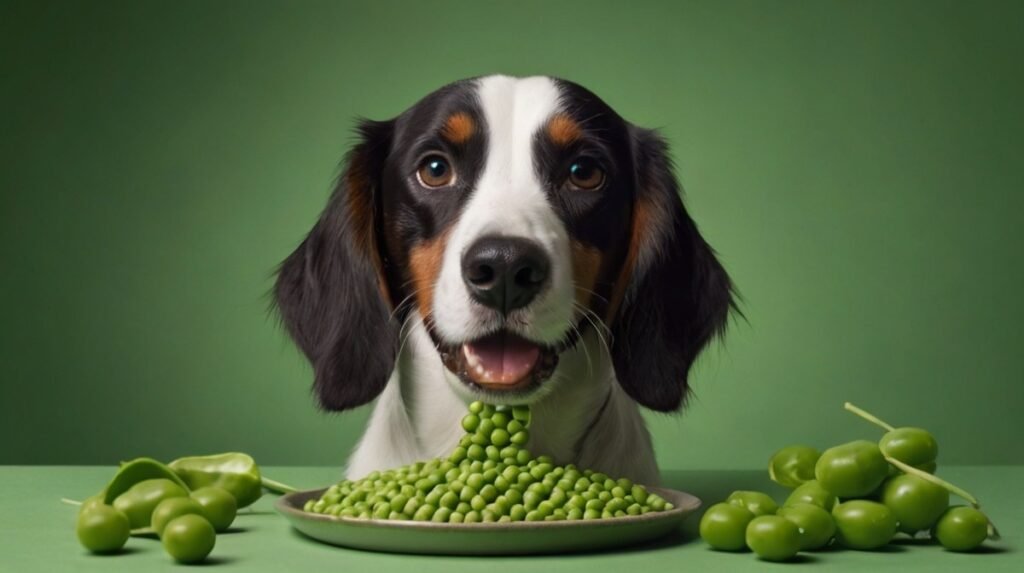
Can Dogs Eat Green Peas Safely? Yes, green peas are generally safe for dogs when given in moderation. These tasty little veggies can provide valuable nutrients that support your dog’s health. Fresh or frozen peas are the healthiest options, while canned peas should be avoided due to added sodium.
It’s always a good idea to consult your veterinarian if your dog has specific health concerns. In this article, we’ll look at the benefits and risks of feeding green peas to your furry friend, helping you make informed choices for their diet. Let’s briefly discuss that-can dogs eat green peas safely?
Nutritional Benefits of Green Peas
Green peas are not just a tasty snack; they also offer a wealth of nutritional benefits that can support your dog’s health. Packed with essential vitamins and minerals, these little green gems can be a valuable addition to your furry friend’s diet. Let’s explore the key nutritional benefits of green peas for dogs.
Vitamins and Minerals:
- Green peas are rich in vitamins A, C, K, and several B vitamins. These nutrients play vital roles in supporting your dog’s immune function, skin health, and overall well-being. Vitamin A, for example, is essential for vision, while vitamin C acts as an antioxidant, helping to combat free radicals.
Dietary Fiber:
- The high fiber content in green peas aids digestion and helps maintain a healthy gut. Fiber can support regular bowel movements and prevent constipation, promoting better digestive health for your dog.
Plant-Based Protein:
- Green peas provide a good source of plant-based protein, which is essential for muscle health and development. Including protein in your dog’s diet can help maintain their muscle mass, especially in active or aging dogs.
Antioxidants:
- These tiny legumes also contain antioxidants, which help boost the immune system and protect your dog’s cells from damage. Antioxidants can contribute to long-term health and vitality, helping your dog feel their best.
Incorporating green peas into your dog’s diet can offer a variety of health benefits. Always remember to serve them in moderation and watch for any signs of allergies or sensitivities. With their rich nutritional profile, green peas can be a safe and healthy treat for your furry companion!
How to Serve Green Peas to Your Dog
Green peas can be a nutritious addition to your dog’s diet, but how you serve them is important for your dog’s health and enjoyment. Here’s a guide on how to properly serve green peas to your furry friend.
Preparation
- Choose the Right Peas:
- Opt for fresh or frozen peas, as these options retain the most nutrients. If you’re using frozen peas, ensure they are thawed before serving.
Cooking Method:
You can lightly steam the peas to make them easier for your dog to digest. Avoid boiling them, as this can wash away some of the nutrients.
Serving Size
- Start Slow:
- Introduce peas gradually into your dog’s diet, beginning with small amounts. This allows you to monitor for any adverse reactions or allergies.
Monitor for Reactions:
Watch your dog closely after serving peas for the first time. Look for signs like itching, digestive upset, or changes in behavior.
Mixing
- Combine with Regular Food:
- You can mix green peas into your dog’s regular food for added nutrition. This can enhance their meal with flavor and texture.
Standalone Treat:
- Alternatively, serve peas as a standalone treat. Dogs often enjoy their sweet taste, making them a great occasional snack.
By following these simple serving suggestions, you can ensure that your dog enjoys green peas safely and healthily. Remember, moderation is key, and always keep an eye on your dog’s reaction to new foods!
Potential Risks of Feeding Green Peas to Dogs
While green peas can be a healthy addition to your dog’s diet, it’s essential to be aware of the potential risks associated with feeding them to your furry friend. Here’s what you need to know about the possible drawbacks of including green peas in your dog’s meals.
Kidney Issues
- Purine Content:
- Green peas contain purines, which can be problematic for dogs with existing kidney issues. High levels of purines may exacerbate their condition, so it’s best to consult your veterinarian if your dog has any kidney-related health concerns.
Gastrointestinal Upset
- Digestive Distress:
- Overeating green peas can lead to gastrointestinal upset in dogs. Symptoms may include gas, bloating, and diarrhea. To avoid these issues, introduce peas gradually and monitor your dog’s response.
Allergic Reactions
- Watch for Symptoms:
- Some dogs may be allergic to peas. Be vigilant for signs of an allergic reaction, such as itching, vomiting, or diarrhea. If you notice any unusual behavior or symptoms after feeding peas, discontinue giving them and consult your veterinarian.
While green peas can be nutritious, it’s crucial to be mindful of these potential risks. Always observe your dog for any adverse reactions, and consult your veterinarian if you have concerns about adding green peas to their diet. This way, you can ensure that your dog enjoys their meals safely!
Recommended Serving Sizes Based on Dog Size
When it comes to feeding green peas to your dog, portion sizes are essential to ensure their health and well-being. Here’s a simple guide on how much green peas you can safely offer based on your dog’s size.
Small Dogs
- Serving Size:
- For small dogs, such as Chihuahuas or Pomeranians, you can give 1 teaspoon to 1 tablespoon of green peas as an occasional treat. This small amount helps prevent digestive upset while still providing a tasty snack.
Medium Dogs
- Serving Size:
- Medium-sized dogs, like Beagles or Cocker Spaniels, can safely enjoy 1-2 tablespoons of green peas mixed with their regular food. This addition can enhance their meals with extra nutrients without overdoing it.
Large Dogs
- Serving Size:
- Large dogs, such as Labradors or German Shepherds, can handle up to 3 tablespoons of green peas, depending on their overall diet and caloric needs. Ensure that this serving fits well within their daily food intake to maintain a balanced diet.
By following these recommended serving sizes based on your dog’s size, you can safely incorporate green peas into their diet. Always introduce new foods gradually and monitor your dog’s reaction to keep their tummy happy and healthy!
Healthier Alternatives to Green Peas for Dogs
While green peas offer various health benefits, there are plenty of other nutritious options you can consider for your furry friend. If you’re looking for healthier alternatives to green peas, here are some great choices that dogs often enjoy!
Carrots
- Nutritional Benefits:
- Carrots are crunchy, low-calorie snacks rich in vitamins A, K, and C. They also contain beta-carotene, which supports eye health and boosts the immune system.
How to Serve:
You can serve raw, chopped carrots as a crunchy treat or cook them lightly for easier digestion.
Pumpkin
Nutritional Benefits:
- Pumpkin is an excellent source of fiber, which helps with digestion and can alleviate issues like constipation. It’s also packed with vitamins A, C, and E.
How to Serve:
Offer plain, cooked pumpkin or canned pumpkin (make sure it’s unsweetened and free of additives).
Green Beans
- Nutritional Benefits:
- Green beans are high in fiber and low in calories, making them a great option for dogs who need to maintain or lose weight. They also provide vitamins C and K.
How to Serve:
Serve them fresh, steamed, or cooked without any seasoning. Cut them into bite-sized pieces for easier consumption.
Apples (Without Seeds)
- Nutritional Benefits:
- Apples are a sweet treat that is rich in vitamins A and C, as well as dietary fiber. They can help freshen your dog’s breath too!
How to Serve:
- Core the apple and slice it into small, manageable pieces, ensuring all seeds are removed.
These healthier alternatives to green peas offer a variety of flavors and nutrients that can enhance your dog’s diet. Always introduce new foods gradually and in moderation to ensure your dog enjoys them without any digestive issues!



